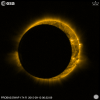
The total solar eclipse observed in March 2015 caught a lot of people's attention, especially as the path of totality passed over most of Northern Europe. There was a great deal of fan-fair and plans to observe the eclipse from the ground. However, due to heavy cloud cover, a lot of people had to turn to space-based observations, such as those made by the sun watching extreme-ultraviolet imager: SWAP, on board the European Space Agency's PROBA2 satellite, which images the Sun from the vantage point of a polar Earth orbit, away from pesky cloud cover. More information about the March eclipse can be found here and here.
SWAP observes the solar corona in a passband centered on a wavelength of 17.4 nm. The structures seen in SWAP images have a temperature of approximately 1 million degrees. More information about the SWAP instrument is available here.
It may come as some surprise, especially for those in Europe, that there was another eclipse observed on 2015-Sep-13. Whether you are able to observe an eclipse from the ground depends on your geographic location, in contrast to the March eclipse which was seen from Northern Europe and the Arctic regions, the September eclipse was observed in the southern hemisphere from Antarctica and southern Africa. In any given year the Earth will experience at least 2 solar eclipses due to the Earth and Moon's orbit.